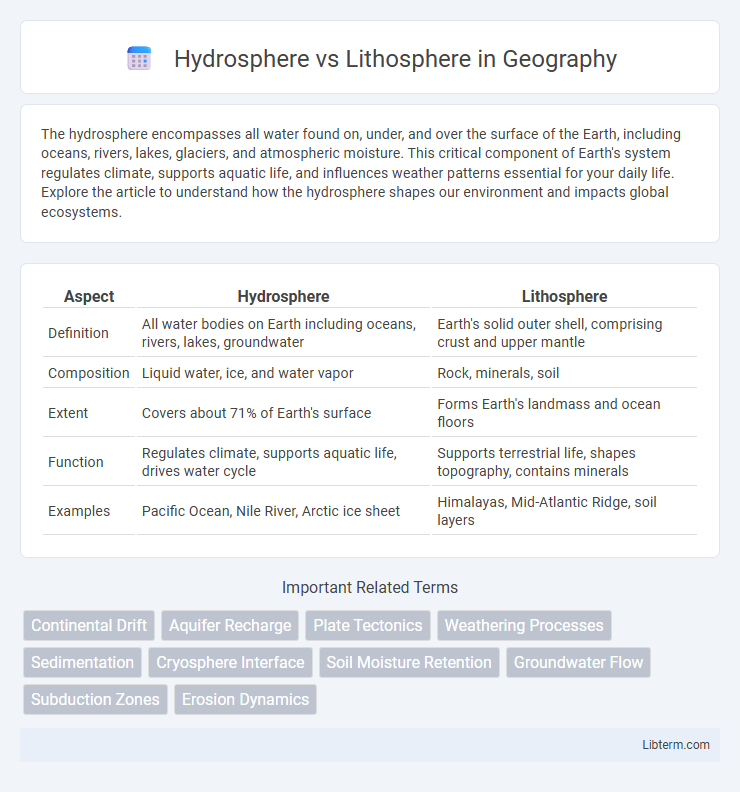The hydrosphere encompasses all water found on, under, and over the surface of the Earth, including oceans, rivers, lakes, glaciers, and atmospheric moisture. This critical component of Earth's system regulates climate, supports aquatic life, and influences weather patterns essential for your daily life. Explore the article to understand how the hydrosphere shapes our environment and impacts global ecosystems.
Table of Comparison
| Aspect | Hydrosphere | Lithosphere |
|---|---|---|
| Definition | All water bodies on Earth including oceans, rivers, lakes, groundwater | Earth's solid outer shell, comprising crust and upper mantle |
| Composition | Liquid water, ice, and water vapor | Rock, minerals, soil |
| Extent | Covers about 71% of Earth's surface | Forms Earth's landmass and ocean floors |
| Function | Regulates climate, supports aquatic life, drives water cycle | Supports terrestrial life, shapes topography, contains minerals |
| Examples | Pacific Ocean, Nile River, Arctic ice sheet | Himalayas, Mid-Atlantic Ridge, soil layers |
Introduction to the Hydrosphere and Lithosphere
The hydrosphere encompasses all water on Earth, including oceans, rivers, lakes, glaciers, and groundwater, playing a crucial role in climate regulation and supporting aquatic life. The lithosphere comprises the rigid outer layer of Earth, consisting of the crust and upper mantle, forming continents and ocean basins essential for tectonic activity and habitats. Interaction between the hydrosphere and lithosphere drives geological processes like erosion, sedimentation, and plate tectonics, shaping Earth's surface.
Defining the Hydrosphere: Components and Features
The hydrosphere encompasses all water bodies on Earth, including oceans, rivers, lakes, glaciers, and underground aquifers, covering approximately 71% of the planet's surface. Its components consist of liquid water, solid ice, and atmospheric water vapor, playing a crucial role in regulating climate and supporting diverse ecosystems. Key features include the continuous movement of water through the hydrological cycle, contributing to nutrient distribution and energy transfer within the Earth's systems.
Understanding the Lithosphere: Structure and Composition
The lithosphere encompasses the rigid outer layer of the Earth, consisting of the crust and the uppermost mantle, and plays a crucial role in tectonic activities and geological formations. Its composition primarily includes silicate minerals such as feldspar, quartz, and olivine, varying between the continental and oceanic crusts, with continental crust being thicker and granitic, and oceanic crust thinner and basaltic. Understanding the lithosphere's structure provides insights into plate tectonics, seismic activity, and the dynamic interactions between Earth's layers that shape the planet's surface.
Key Differences Between Hydrosphere and Lithosphere
The hydrosphere encompasses all water bodies on Earth, including oceans, rivers, lakes, and groundwater, while the lithosphere refers to the rigid outer layer of the Earth composed of the crust and upper mantle. The hydrosphere plays a crucial role in regulating climate and supporting aquatic ecosystems, whereas the lithosphere provides the foundation for terrestrial life and is the source of minerals and fossil fuels. Key differences include their composition, with the hydrosphere consisting of liquid water and the lithosphere made of solid rock, and their dynamic processes, such as the water cycle in the hydrosphere versus plate tectonics in the lithosphere.
Interactions Between Hydrosphere and Lithosphere
The interactions between the hydrosphere and lithosphere are crucial in shaping Earth's surface through processes such as erosion, weathering, and sediment deposition. Water from rivers, glaciers, and rainfall transports sediments across the lithosphere, influencing soil formation and landscape morphology. These dynamic exchanges also affect nutrient cycling, groundwater recharge, and habitat development in various ecosystems.
The Role of the Hydrosphere in Earth's Ecosystems
The hydrosphere, encompassing all water bodies like oceans, rivers, and groundwater, plays a crucial role in regulating Earth's climate and sustaining biodiversity across ecosystems. It facilitates nutrient cycling, supports aquatic habitats, and influences weather patterns essential for terrestrial life. The interaction between the hydrosphere and lithosphere shapes soil fertility and ecosystem productivity, highlighting the interdependence of Earth's spheres.
The Importance of the Lithosphere for Life and Resources
The lithosphere provides essential minerals and nutrients that support terrestrial ecosystems and agricultural productivity, underpinning all terrestrial life. It acts as the foundation for habitats and influences climate regulation through soil formation and carbon storage. Access to fossil fuels, metals, and minerals within the lithosphere drives human civilization and technological advancement.
Human Impact on the Hydrosphere and Lithosphere
Human activities significantly alter the hydrosphere through pollution, over-extraction of freshwater resources, and climate change-driven sea-level rise, disrupting aquatic ecosystems and water availability. The lithosphere experiences extensive human impact from urbanization, deforestation, mining, and agriculture, leading to soil erosion, habitat loss, and land degradation. These cumulative effects on both spheres contribute to reduced biodiversity and destabilize natural cycles essential for sustaining life on Earth.
Climate Change Effects on Hydrosphere vs Lithosphere
Climate change accelerates the melting of glaciers and ice caps, causing sea level rise and increased ocean temperatures that disrupt marine ecosystems in the hydrosphere. In the lithosphere, intensified weathering, soil erosion, and permafrost thaw lead to land degradation and release of trapped greenhouse gases, exacerbating global warming. These dynamic interactions between hydrosphere and lithosphere amplify environmental stress and threaten biodiversity and human infrastructure.
Conclusion: Balancing the Hydrosphere and Lithosphere for a Sustainable Future
Achieving a sustainable future depends on the delicate balance between the hydrosphere and lithosphere, as their interactions regulate Earth's climate, water cycle, and land stability. Protecting water quality and managing land resources responsibly help mitigate environmental degradation, ensuring ecosystem resilience. Integrated conservation strategies targeting both spheres promote long-term sustainability for human societies and natural habitats.
Hydrosphere Infographic

 libterm.com
libterm.com